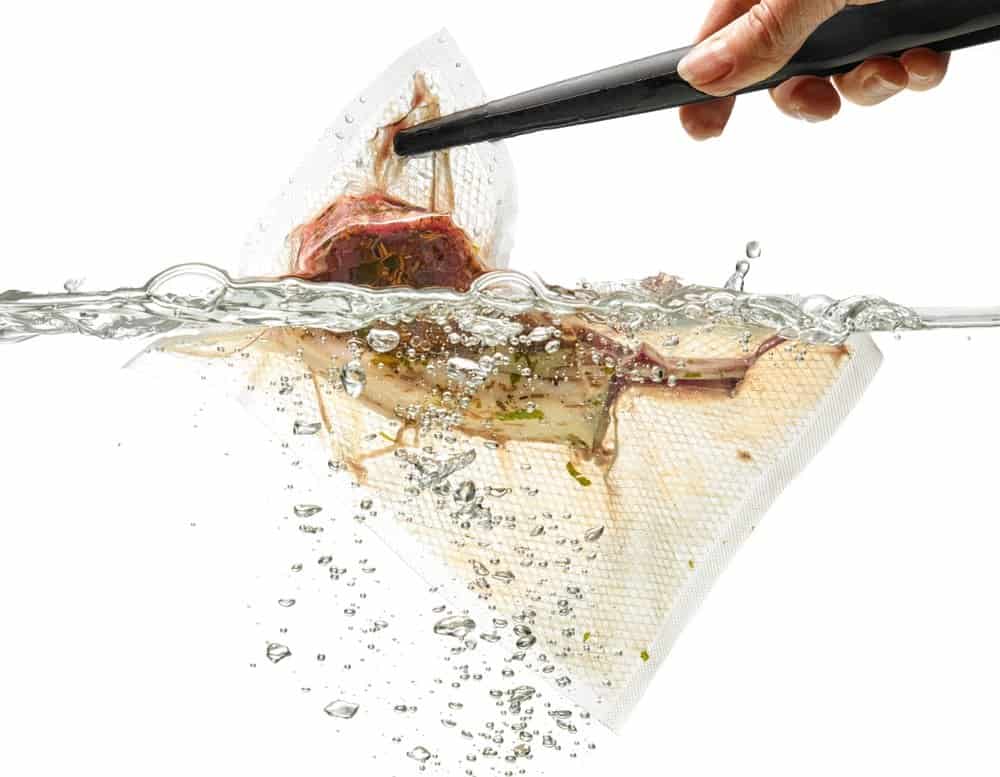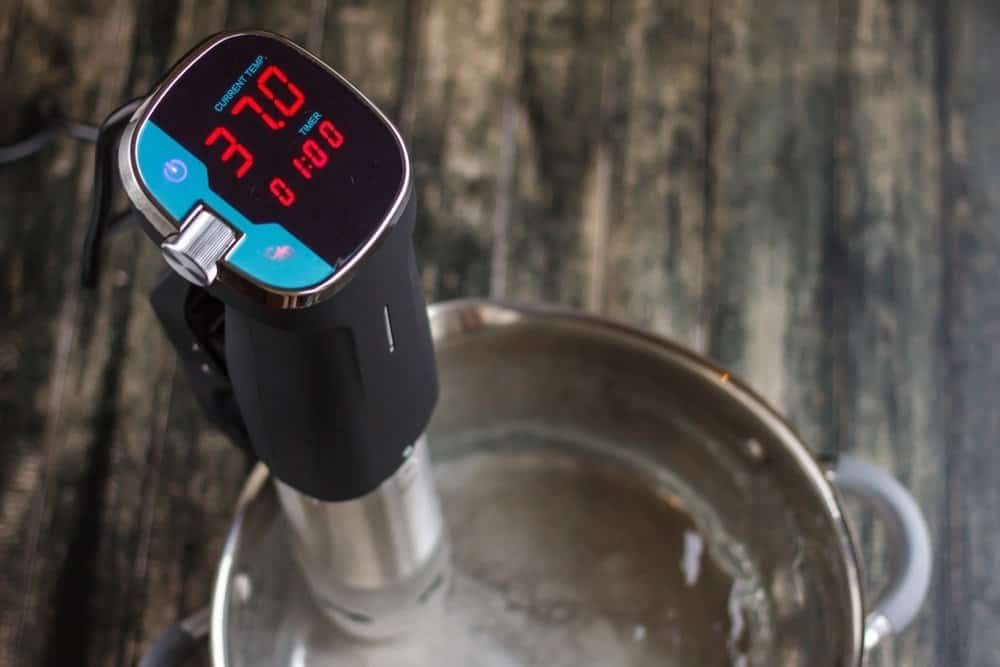What Is the Sous Vide Method of Cooking?
Have you heard the term “sous vide” before, likely while watching the Food Network or maybe at an upscale restaurant?
For those of you wondering what the sous vide method of cooking is, read on for my detailed explanation of this innovative way of cooking and why you should use it at home.

What Is the Meaning of Sous Vide?
Sous vide (pronounced “soo veed”) is a French term that means “under vacuum.” It refers to the method of cooking that involves sealing food in an airtight bag and cooking it at an exact temperature in a water bath.
The “vacuum” comes from the commonly used sous vide method of placing food in vacuum sealed bags as a part of this cooking process.
Now that we know what sous means and have a general idea of what it is, let’s get into more detail about how sous vide cooking works and why you should use it.
What Is Sous Vide Best Used For?
Sous vide is mostly known to be used for cooking proteins, or in other words, meat. But there are many other things that you can cook with your sous vide machine—check out the list below!
- Steaks
- Pork chops
- Chicken breast, turkey breast, duck breast
- Seafood (eg., lobster, fish, shrimp)
- Burgers, including meatless burgers or veggie burgers
- Eggs (whether it’s scrambled, poached, or pasteurized) or egg bites
- Beef tongue
- Chicken feet
- Oxtail
- Vegetables (eg., carrots, asparagus)
- Yogurt
- Crème fraîche
- Custards (eg., cheesecake, crème brûlée, bread pudding)
- Cocktails
- Ice cream
- Cheese
You might have been surprised by some of the things on this list that you can make with sous vide cooking. Click here to learn more!
Main Steps of the Sous Vide Process
“Doneness” is the biggest battle all cooks face with proteins, and the sous vide method of cooking is a solution for this problem. So how do you cook with this fantastic method?
The main ingredient (which is usually meat but you can also sous vide vegetables and even eggs) is placed in a Ziploc or vacuum sealed bag with whatever spices, herbs, sauce, or marinade you want to use, and the air is removed from the bag.
The bag is then submerged in a container filled with water that has been brought to an exact temperature by the sous vide cooker. The temperature of the water bath is constant throughout, never fluctuates, and never comes to a boil. The cooking process is controlled and steady and doesn’t involve steam, flames, or smoke.

Is Sous Vide Worth It?
If you’re sous vide cooking a piece of meat, the meat is gradually brought up to the exact temperature of the water bath evenly throughout (so from the outside of the meat to the center). The contents cook evenly in their own juices and flavoring for amazing tenderness and juiciness. It generally takes longer to cook sous vide, as meat for example takes a couple of hours, but it’s an extremely precise and gives you perfect results time after time. Well worth the wait.
Compare this to cooking a piece of meat on the stove, where heat is applied directly to the outside of the meat at a high temperature to raise the internal temperature of the meat to cook it. So by the time you get the center of the meat to your desired temperature, the outside of the meat is even hotter. That’s why, when you cut the meat in half, you see a gradient of temperature (and color) running through the meat. So in other words, the meat is not evenly cooked throughout, and the only “perfectly” cooked part is the center.
Also, when cooking on the stove, you most likely have to use a thermometer, continuously watching it while you have to keep turning the heat up and down to make sure the pan stays at a constant temperature. Definitely more of a hassle compared to the “set it and forget it” nature of sous vide cooking that makes it near impossible to overcook food.
So how do sous vide machines keep the water at a constant temperature? There’s one type of sous vide machine called an immersion circulator that circulates the water bath to keep it at an even temperature throughout the entire container. This prevents any hot or cold spots in the water bath. There’s also another type of sous machine called a water oven, that has a built in water bath that it heats up to your desired temperature. I get into the details of these two types of sous vide machines below.
Beyond the fact that sous vide cooking is so precise, another benefit is that the process of sous vide cooking is quite easy and not as involved as you might think. Once the temperature of the water bath is set and the bag is fully submerged, there’s nothing else for you to do but wait until the cooking time is up.

If you’re cooking meat, you won’t get that caramelized, crispy sear with sous vide cooking as you would cooking on the stove. That being said, you can easily do a quick sear on the pan for about a minute on each side after cooking it sous vide and letting it rest to seal in the flavor. What’s great is that a quick sear like this won’t cook the inside of the meat any further, so you can have the best of both worlds.
Also, after the sous vide cooking process, you can use the leftover sous vide juices in the bag to elevate your dish even further! Click here to see what you can do with sous vide juices, including how to make a sauce out of it.
Given the ease and simplicity of the sous vide cooking process, it makes cooking in bulk (like for meal prep for the week or a large dinner party) extremely manageable. All you have to do is sous vide a few pork chops or steaks ahead of time and store them in the fridge. Then when you’re ready to eat, just take them out of the fridge and let them get to room temperature, give them a quick sear, and voila! You have flavorful, perfectly and evenly cooked dishes for your dinner guests or dinner for the week.
Finally, clean-up with sous vide is extremely easy. You can just throw out the food bags after cooking with them and dump the water from the container. Unless you plan to sear or finish your food, you don’t have to deal with scrubbing greasy pans!
For more on the pros and cons of sous vide cooking, click here.
Sous Vide Immersion Circulator vs. Water Oven
There are two main types of sous vide machines: immersion circulators and water ovens.
The sous vide immersion circulator is a standalone device that both heats and circulates water. To use these you also need some sort of pot or container to hold the water. These are generally more affordable and are perfect for at-home use. Read more about sous vide immersion circulators here.
The sous vide water oven, also referred to as a countertop water bath, has a built-in water bath that it heats up (but doesn’t circulate). For this reason they’re much larger than immersion circulators (about the size of a microwave). They’re also self-contained with their own lid, for proper insulation. Read more about sous vide water ovens here.
In Summary
In closing, the sous vide method of cooking is an extremely precise way to cook your food in an airtight bag submerged in a temperature-controlled water bath.
So is sous vide worth it? My answer is yes! Sure the cooking time may be a bit longer, but here’s what you get that’s well worth the wait:
- Food cooked to perfection
- The option to sear to seal in the flavor if you want to
- Tender and juicy cuts of meat
- More complex flavors
- Consistently perfect results every time
- An easy cooking process that’s hands-free once everything is set up
- An easy method of cooking in bulk
- Easy clean-up






